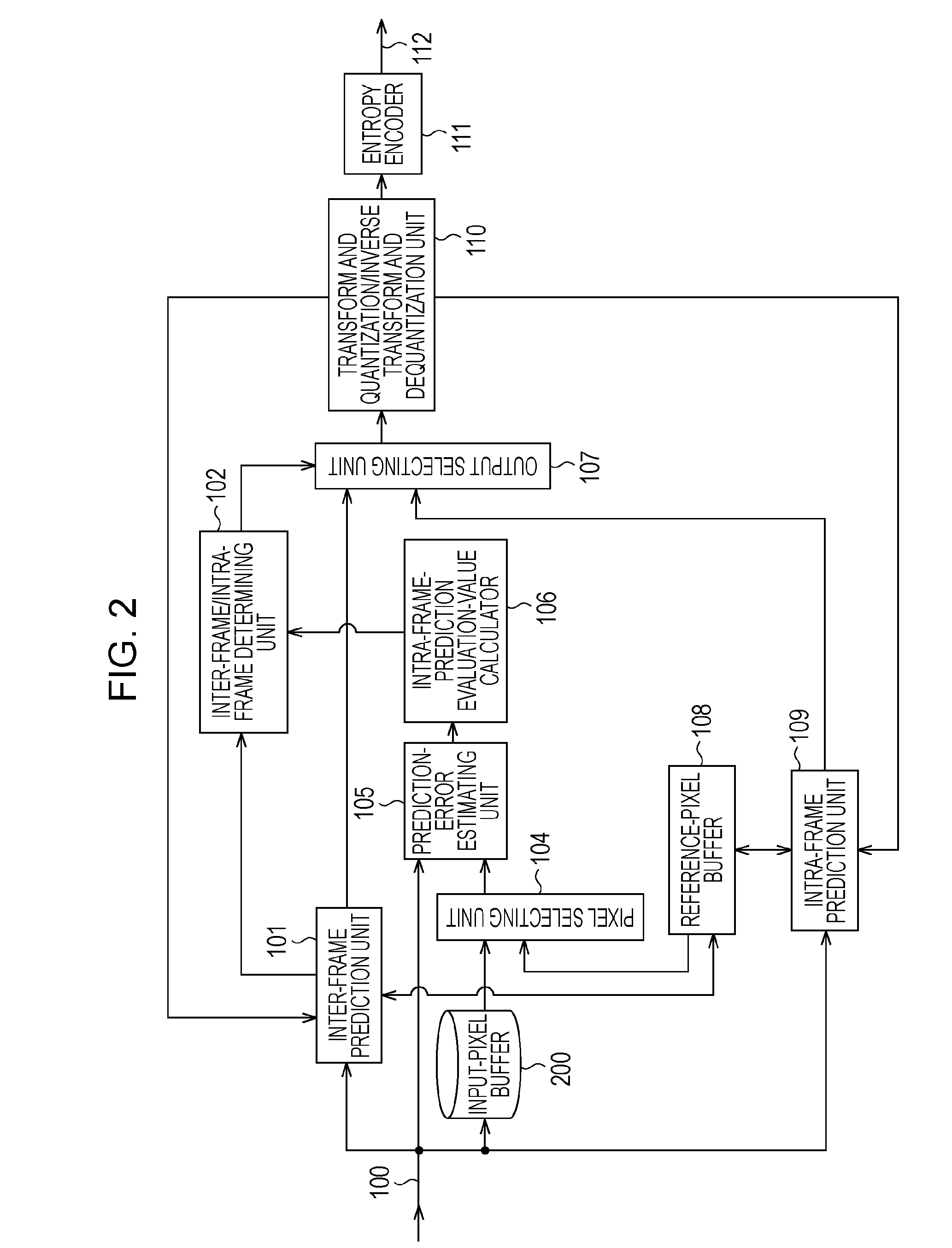Image encoding apparatus and image encoding method
a technology of image encoding and encoding methods, applied in the field of prediction encoding apparatuses, can solve problems such as inability to use methods, inability to use inter-frame prediction or intra-frame prediction, and inappropriate decision regarding inter-frame prediction or intra-frame prediction, and achieve the effect of efficient compression encoding
- Summary
- Abstract
- Description
- Claims
- Application Information
AI Technical Summary
Benefits of technology
Problems solved by technology
Method used
Image
Examples
first embodiment
[0028]FIG. 1 is a block diagram showing an example functional configuration of an image encoding apparatus according to a first embodiment of the present invention. The first embodiment is described in the context of an example where image data yet to be encoded, representing an input image, is encoded according to the H.264 standard.
[0029]An inter-frame prediction unit 101 executes an inter-frame prediction operation regarding an input image 100 to output inter-frame prediction errors. An inter-frame / intra-frame determining unit 102 determines whether inter-frame prediction or intra-frame prediction is to be used for processing of a next macro block.
[0030]A pseudo-reference-pixel setting unit 113 sets arbitrary pseudo-reference-pixel signals 103 as values of pseudo reference pixels. For example, the pseudo-reference-pixel signals 103 may be signals representing a predetermined image or an image obtained by executing interpolation on the input image 100 or filtering the input image ...
second embodiment
[0051]Next, a second embodiment of the present invention will be described with reference to FIG. 2. FIG. 2 is a block diagram showing an example of a functional configuration of an image encoding apparatus according to the second embodiment. In FIG. 2, 100 to 112 denote items corresponding to those denoted by the same numerals in the first embodiment described with reference to FIG. 1. In FIG. 2, 200 denotes an input pixel buffer that stores data corresponding to one macro block of the input image 100 and that outputs the data to the pixel selecting unit 104 after a delay corresponding to one macro block.
[0052]In this embodiment, when reference pixels are temporally available, the pixel selecting unit 104 outputs the reference pixels stored in the reference-pixel buffer 108, and when reference pixels are not available, the pixel selecting unit 104 outputs the data stored in the input pixel buffer 200.
[0053]The input pixel buffer 200 supplies to the pixel selecting unit 104 data of ...
third embodiment
[0055]Next, a third embodiment of the present invention will be described with reference to FIG. 8. FIG. 8 is an enlarged view of the left reference macro block 401a in this embodiment. Since the image encoding apparatus according to the third embodiment is configured the same as the image encoding apparatus according to the first embodiment, further description thereof is omitted.
[0056]In FIG. 8, reference marks 401a and 500 denote items corresponding to those denoted by the reference marks in FIGS. 4 and 5. A latest reference pixel 800 for which encoding and local decoding have been finished is illustrated in black. Pixels indicated in black and enclosed by a broken line 801 are pixels for which encoding and local decoding have not been finished. In this embodiment, as opposed to the second embodiment, when reference pixels are not available, the pseudo-reference-pixel setting unit 113 sets the latest locally decoded reference pixel as pseudo reference pixels. That is, the value o...
PUM
 Login to View More
Login to View More Abstract
Description
Claims
Application Information
 Login to View More
Login to View More - R&D
- Intellectual Property
- Life Sciences
- Materials
- Tech Scout
- Unparalleled Data Quality
- Higher Quality Content
- 60% Fewer Hallucinations
Browse by: Latest US Patents, China's latest patents, Technical Efficacy Thesaurus, Application Domain, Technology Topic, Popular Technical Reports.
© 2025 PatSnap. All rights reserved.Legal|Privacy policy|Modern Slavery Act Transparency Statement|Sitemap|About US| Contact US: help@patsnap.com



